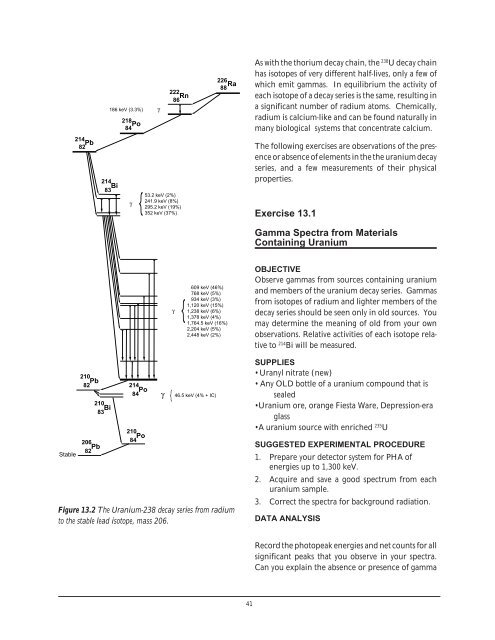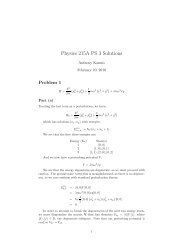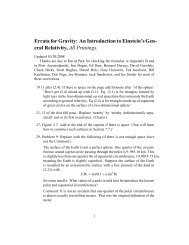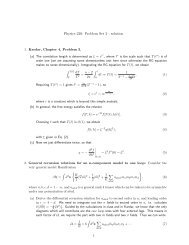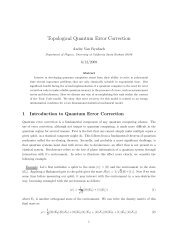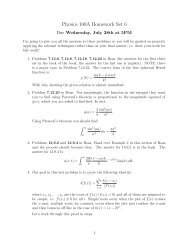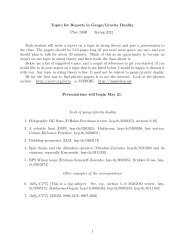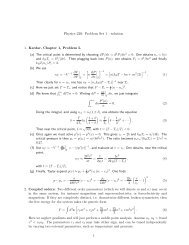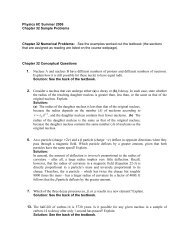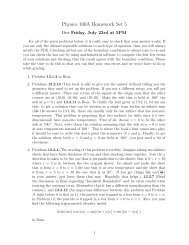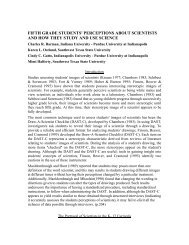Nuclear Spectroscopy
Nuclear Spectroscopy
Nuclear Spectroscopy
Create successful ePaper yourself
Turn your PDF publications into a flip-book with our unique Google optimized e-Paper software.
186 keV (3.3%)<br />
218<br />
Po<br />
84<br />
γ<br />
222<br />
Rn<br />
86<br />
226<br />
Ra<br />
88<br />
As with the thorium decay chain, the 238 U decay chain<br />
has isotopes of very different half-lives, only a few of<br />
which emit gammas. In equilibrium the activity of<br />
each isotope of a decay series is the same, resulting in<br />
a significant number of radium atoms. Chemically,<br />
radium is calcium-like and can be found naturally in<br />
many biological systems that concentrate calcium.<br />
214<br />
Pb<br />
82<br />
214<br />
83 Bi<br />
γ<br />
53.2 keV (2%)<br />
241.9 keV (8%)<br />
295.2 keV (19%)<br />
352 keV (37%)<br />
The following exercises are observations of the presence<br />
or absence of elements in the the uranium decay<br />
series, and a few measurements of their physical<br />
properties.<br />
Exercise 13.1<br />
Gamma Spectra from Materials<br />
Containing Uranium<br />
γ<br />
609 keV (46%)<br />
768 keV (5%)<br />
934 keV (3%)<br />
1,120 keV (15%)<br />
1,238 keV (6%)<br />
1,378 keV (4%)<br />
1,764.5 keV (16%)<br />
2,204 keV (5%)<br />
2,448 keV (2%)<br />
OBJECTIVE<br />
Observe gammas from sources containing uranium<br />
and members of the uranium decay series. Gammas<br />
from isotopes of radium and lighter members of the<br />
decay series should be seen only in old sources. You<br />
may determine the meaning of old from your own<br />
observations. Relative activities of each isotope relative<br />
to 214 Bi will be measured.<br />
Stable<br />
210<br />
82 Pb<br />
210<br />
83 Bi<br />
214<br />
84 Po<br />
210<br />
206<br />
82 Pb<br />
84 Po<br />
Figure 13.2 The Uranium-238 decay series from radium<br />
to the stable lead isotope, mass 206.<br />
γ<br />
46.5 keV (4% + IC)<br />
SUPPLIES<br />
• Uranyl nitrate (new)<br />
• Any OLD bottle of a uranium compound that is<br />
sealed<br />
•Uranium ore, orange Fiesta Ware, Depression-era<br />
glass<br />
•A uranium source with enriched 235 U<br />
SUGGESTED EXPERIMENTAL PROCEDURE<br />
1. Prepare your detector system for PHA of<br />
energies up to 1,300 keV.<br />
2. Acquire and save a good spectrum from each<br />
uranium sample.<br />
3. Correct the spectra for background radiation.<br />
DATA ANALYSIS<br />
Record the photopeak energies and net counts for all<br />
significant peaks that you observe in your spectra.<br />
Can you explain the absence or presence of gamma<br />
41


